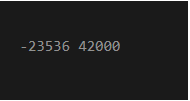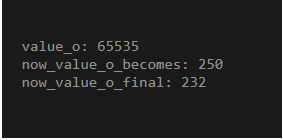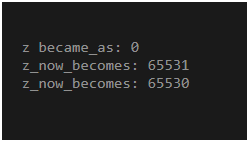Updated April 13, 2023

Definition of C++ unsigned int
C++ unsigned int is the data types that contain integers in the form of non-negative whole numbers only. Unlike C++ signed integer which can possess both negative and positive whole numbers, C++ unsigned int can possess only positive integers which can range from 0-255, and thus it can store 256 different values out of which half of their signed integers contain negative numbers. C++ unsigned int is the best option whenever the requirement is to use positive integers as it is compatible with networking and systems to deal with optimization with respect to memory for networking and systems.
Syntax of C++ unsigned int
The syntax flow for C++ unsigned int is as follows:
unsigned int un_intUnsigned keyword followed by an integer and the value to be passed as parameter later point of time represented as un_int. Similarly, there are other ways to declare unsigned integer with respect to other data types:
unsigned short un_sUnsigned keyword followed by short type integer.
unsigned long un_lngUnsigned keyword followed by long type integer.
unsigned long long un_lngUnsigned keyword followed by nested long type integer.
How unsigned int Work in C++?
- unsigned int in C++ is a data type which holds for non-negative values ranging from 0-255
- It is used for 1-byte signed integer which ranges from -128 to 127 that is used to store values which are compatible with the negative values for requirements related to networking and systems with little memory as unsigned integers comprises of positive values that don’t take up extra memory at the time of allocation and implementation.
- If the user tries to store a value more than that of the defined range, then it experiences some errors as unsigned integers cannot overflow.
- If the value assigned becomes out of range, then it is divided by one of the greatest numbers, and only the remainder is kept for further computation.
- There is another way which mostly asks for wrapping up of the number with modulo wrapping as functionality and then getting the remainder as the value which is used for storing the value. For example: if the value is 280 which is completely out of range then it will select for the upper bound of the range and then make a full round off to the value.
- There are certain ranges which are defined for unsigned integers such as for 1-byte unsigned integer have a range of 0-255, then for 2 bytes unsigned integer range from 0 to 65535, 4 bytes unsigned integer 0 to 4,294, 967,295 and for 8 bytes unsigned integer it ranges from 0 to 18,446,744,073,709,551,657.
- Sometimes programmers get confused with the signed and unsigned integers so the simple way to identify the difference is to use a negative sign but in case no sign is provided properly then it is required to assume the number as positive and then making the values estimated and use properly.
- May programmers also think another way round like the usage of unsigned integers should be less because of the two behaviors and problem it causes at the time of implementation like some often face the problem related to the representation of unsigned number with the negative sign because it will give a wrong instinct with respect to the codebase. This situation arises at the time of subtraction which is not at all conventional.
- Another problem that is often faced is when the programmers introduce the data type with a mix means both with signed and unsigned type integers causing to prompt for the sign which is not accepted or desired by the programmers when dealing with unsigned integers.
- Therefore, there are certain interesting fields where the user should use C++ unsigned integers without giving a second thought and that is whenever the user wants to deal with manipulation in bits.
- Wherever there is a need to develop embedded systems comprising of processors or memory limited activity there only a need for C++ unsigned integer.
- Lastly, it plays a pivotal role when the programmers deal with array and array indexing a huge number of unsigned integers gets manipulated in some or the other way as per requirement which religiously makes use of C++ unsigned integers when compared with signed integers.
Examples of C++ unsigned int
Following are the examples are given below:
Example #1
This program demonstrates the difference and manipulation between signed and unsigned integers at the time of execution as shown in the output.
Code:
#include <iostream>
using namespace std;
int main() {
short int_m;
long unsigned int_n;
int_n = 42000;
int_m = int_n;
cout << int_m << " " << int_n;
return 0;
}Output:
Example #2
This program demonstrates the unsigned int overflow which means that if the value given in the form of unsigned int and the value is more than expected the unexpected implicit conversion takes place for the final conversion of the value in some of the other form as shown in the output.
Code:
#include <iostream>
int main()
{
unsigned short o{65535};
std::cout << "value_o: " << o << '\n';
o = 65786;
std::cout << "now_value_o_becomes: " << o << '\n';
o = 65768;
std::cout << "now_value_o_final: " << o << '\n';
return 0;
}Output:
Example #3
This program demonstrates the representation of unsigned int value which is not convenient if some negative value is thrown in the output thus makes less desirable by the programmers as shown in the output.
Code:
#include <iostream>
int main()
{
unsigned int_lx{ 2 };
unsigned int_my{ 9 };
std::cout << int_lx - int_my << '\n';
return 0;
}Output:
Example #4
This program demonstrates the representation of unsigned int where the wrapper class takes care to make around off to the values which are negative numbers instead of positive values as shown in the output.
Code:
#include <iostream>
int main()
{
unsigned short z{ 0 };
std::cout << "z became_as: " << z << '\n';
z = -5;
std::cout << "z_now_becomes: " << z << '\n';
z = -6;
std::cout << "z_now_becomes: " << z << '\n';
return 0;
}Output:
Conclusion
Unsigned integers are the integers that are preferred by the programmers the requirement is related to optimized and easy code when dealing and manipulating with the bits. Programmers or developers make use of unsigned integers whenever the values require playing around with the array and indexing of arrays as well.
Recommended Articles
This is a guide to C++ unsigned int. Here we also discuss the definition and how unsigned int work in c++ along with different examples and its code implementation. You may also have a look at the following articles to learn more –





